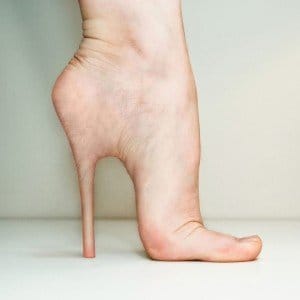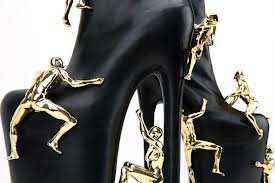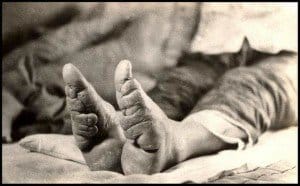The Demise of Powerful Femininity Starts with High Heels
If high heels were so wonderful, men would be wearing them. – Sue Grafton
The end of World War II and the return of men to the home front sent newly emancipated Rosie the Riveters back to traditional households and baby rearing. The freedom promised by wartime work and the 1950s “discovery” of the female orgasm by Kinsey created a new opening for fully awakened, powerful womanhood. But this opening soon ran into blocks: new ways to keep sexuality under control, in ways subtle and large.
One of those less obvious controls was the haute couture embrace of sky-scraping stiletto heels, which both sexualized women and limited their freedom of movement, abusing their feet and the floors they stalked across. Women’s feet haven’t been the same since.
At the risk of sounding like a sexist, let me ask a simple question: What makes a nice pair of legs? For a lot of women, I’m guessing it’s really not what they were born with, those lovely lower limbs that keep their feet connected to their torso. Yes, you could go through painful leg-lengthening surgery or foot conforming plastic surgery to enjoy the putative benefits of being taller or look better in heels. Or you could drop that $1,000 on a ridiculous pair of Louboutins or Manolos. Most opt for the latter, even if it exacts its own steep price in hobbling pain over time.

For a lot of women, a pair of great legs depends on a pair of great shoes. It’s what they’re wearing that matters, not what they were born with.
When I’m not working I just like to be comfortable: I love black, nothing tight, no heels, no make-up – it’s nice to be able to breathe! Eva Green
And by shoes, they usually don’t mean ballet flats or cross-trainers or “sensible” pumps. No, usually what matters is some pricey and unlikely engineering marvel that defies structural laws, for both footwear and feet. It means some nutty construct that arches up in an impossible parabola to the heel, then plunges 3 or 4 or 5 (or 6) inches to the floor like an Acapulco cliff diver.
This vertiginous set of values brings it with much that is seldom acknowledged by the fashion industry, women, or the men who admire them. As one site enumerates, heels “may contribute to knee and back problems, disabling injuries in falls, shortened calf muscles, and an awkward, unnatural gait.” Osteoarthritis is twice as common in women, and doctors blame high heels for that too.
Time wounds all heels.– Jane Sherwood Ace
In pedestrian-averse Los Angeles, many women may not even own a pair of tennis shoes. Then they may say they can’t cross the street because they wore the wrong shoes. It’s all to the greater glory and revenue streams of convenient valet parking, but what happens when we want to do one of those long walks on the beach at sunset?
By the measure of too many, a great pair of legs starts at Jimmy Choos, rather than good exercise and diet and moderately fortunate genes. For too many, I think, a great pair of legs is defined by how much the shoes they’re strapped into can distort the natural curve of their foot. A great pair of legs, for too many, is measured by how much altitude a woman can artificially jack onto her frame, even it leaves her tottering, tattered and tired.
Such shoes exact a cost, one that women don’t always like to acknowledge. Research suggests more women are wearing higher heels, and wearing them longer. And the more they do both, the more likelihood that they will suffer permanent problems ranging from disfiguring but relatively minor conditions such as “hammer toes” and bunions all the way to crippling damage to nerves and tendons. Research suggests as many as 3 in 10 women may face these problems because they wear high heels practically all the time
I used to wear heels because I wanted to show people I wasn’t ashamed of being tall. But I don’t wear them any more because you don’t have to wear heels to be beautiful. I can’t even remember the last time I wore heels. – Elle MacPherson
Why do women do this? Because they believe high heels make them look better. Or make them look taller. Or make their legs look thinner or more sexually inviting or more physically imposing. Maybe heels do work to attract some men: studies show that heels tilt the pelvis and thrust the breasts forward, sexualizing a woman, and making men more likely to respond to her in a crowd.
But the other aspects of wearing heels are derived from a culturally imposed image of women in power, wherein power and sexuality often blur. Women at the top of almost every industry from publishing to entertainment to fashion to advertising wear spike heels, and usually the rest of the social armor that goes with it – luxe clothing, pricey jewelry, perfect hair, Chanel lipstick.
The very real aspect of this armoring up is that it can put you in a mindset of doing aggressive and focused work, of girding for the daily battle, and much more so than wearing tennis shoes.
In some ways, it indeed has a signaling effect to your own brain of “Game on!” And there can indeed be an added advantage, particularly for shorter women, that heels bring them at least closer to eye to eye with the men in the boardroom. After all, the tight correlation between height, power and wealth is a real phenomenon
But, lik.e all other culturally imposed artifacts, if it’s wrong and doing real damage to our bodies (and the rest of us, too) we should question it and change it.
I talked about these issues with my friend Dr. Taryn Rose, an orthopedic surgeon who was so outraged and frustrated by the shoe industry’s affection for foot abuse that she launched her own company to make healthier footwear. Now, her company sold $40 million a year in sales of shoes with heels of 2 inches or less, most just half an inch high.
“I find it unconscionable that there are foot doctors (podiatrists, not orthopedic surgeons) who shorten toes, cut off the fifth toe, inject fillers to the soles of women’s feet just so women can wear these sky high heels,” Taryn told me. “What women don’t understand is that the biomechanics of the feet are very delicate. Altering one toe will cause transfer stress to the other toes and you open up the Pandora’s shoebox.”
Fashion is something barbarous, for it produces innovation without reason and imitation without benefit. – George Santayana
And here’s the deal: You look great the way you are, and you definitely look better when you haven’t purposely hobbled yourself like some modern victim of Chinese-style foot-binding.
I know, I know. Skeptics out there say I would only write this because I’m a medium-height guy who gets tired of having to walk slowly so some woman towering over me in 5-inch heels can keep up on a simple stroll. Yes, I’m 5’8” and love it. And yes, I routinely walk (in flat shoes, no lifts!) faster than most people jog. We’ve got places to go, things to do, lots to see.
But I’ve written a lot about the virtues and beauties of simplicity, especially for women who too frequently are torturing and even disfiguring their bodies in a quest to appear beautiful to, well, whom? Men? Other women? Themselves?
To me, women are beautiful as they are. Adding 5 inches to your height, while making it difficult to walk easily or healthily, doesn’t serve anyone in the long run. Research pretty definitively shows that 3-inch or higher heels, worn extensively, are bad news for bodies, potentially permanently. How is that going to look sexy? Do you need that? Don’t you think you have enough to offer to a potential mate or dinner companion without doing that to yourself, potentially forever?
Taryn has some suggestions for women negotiating a world where high heels are high fashion, without causing high impact on their tortured tootsies:
“Be moderate and save heels for special occasions. Treat it like dessert, (and do it) only on Saturday nights.You can decrease the amount of damage and pain slightly by being in better shape: a strong core can offset the stress in the lower back, and stronger quads and hamstrings will reduce stress on the knees. Daily high heel wearers should stretch their calves’ daily too, or risk being in pain even in bare feet.”
These are all great suggestions from someone who knows what she’s talking about.
More broadly though, there’s a different way to think about this. When we strip our demands on ourselves down to the essentials, and focus on the things that really matter, we often are surprised by how much lighter we feel going through life, how much easier it is to move forward and how little we miss the “important” things we gave up.
This happens in business too. When we focus on the basics of business, of taking care of our clients or customers, and worry less about chasing trends or window dressing, business thrives. It’s easy for executives to get caught up in “me, too” deals and initiatives that take a company’s focus away from its core competencies. Don’t do it. Like the woman who opts for flats instead of stiletto heels, you may be surprised how well the new look fits. Go ahead, try on something different.
I say,
It’s in the click of my heels,
The bend of my hair,
the palm of my hand,
The need of my care,
‘Cause I’m a woman
Phenomenal woman,
That’s me. Maya Angelou















Anthony, really? Ok, now I’m going to comment. The ability to wear high heels “well”, also depends on your body type. I was drawn to stilettos on my own at 13. I never understood nor found flat shoes comfortable, not even to this day. I wore a minimum of 3 inch heels when I was pregnant with 10 lbs (at birth) boys. I never found heels constricting. I wouldn’t wear a pair I couldn’t run in. And I was a former leg model so I never wore heels as a leg-lengthening mechanism. I love heels. I have a high arch which may also be the reason why heels are so comfortable, generally. I feel like a duck in flats. And heels do “lift” you, and I guess for me that’s both mentally and physically.